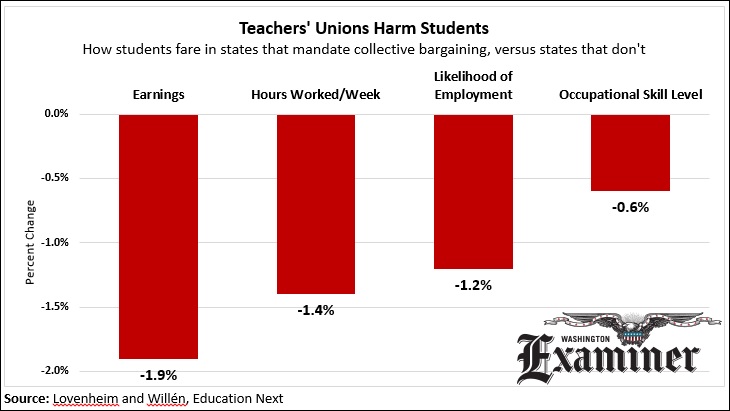Teachers’ unions insist they have students’ best interests at heart when it comes to politics, but new evidence suggests collective bargaining is harming students.
Students end up earning less if they are educated in states where school districts are forced to collectively bargain with a teachers’ union, according to a new study published Tuesday in Education Next. They are also less likely to find a job.
The study is the first evidence on how collective bargaining affects students’ employment and earnings prospects in adulthood. The news for teachers’ unions is not good.
Related Story: http://www.washingtonexaminer.com/article/2575923
“Laws requiring school districts to engage in collective bargaining with teachers unions lead students to be less successful in the labor market in adulthood,” authors Michael Lovenheim and Alexander Willén write in the study. “Students who spent all 12 years of grade school in a state with a duty-to-bargain law earned an average of $795 less per year and worked half an hour less per week as adults than students who were not exposed to collective bargaining laws.
“They are 0.9 percentage points less likely to be employed and 0.8 percentage points less likely to be in the labor force. And those with jobs tend to work in lower-skilled occupations.”
The nation loses $196 billion per year on those educated in states that mandate collective bargaining for teachers.
Collective bargaining has the potential to harm students, making it harder to fire bad teachers. Stronger unions also make it harder to expand school choice or enact certain education reforms. The study did not seek to explain why collective bargaining was bad for students, only how collective bargaining affects them.
“Taken as a whole, our results clearly indicate that laws supporting collective bargaining for teachers have adverse long-term consequences for students,” Lovenheim and Willén write. Both researchers are with Cornell University.
Lovenheim and Willén compared the differences in several factors before and after a collective bargaining mandate took effect to the differences in the same factors for states with no collective bargaining mandate. Currently, 34 states require schools to collectively bargain with teachers, while seven prohibit bargaining and nine permit it.
To be fair, the data are old, in a way: The study looked at students who were educated in the 1970s and 1980s and are now adults. The results might be different for students who are being educated now, but we can’t know for sure until today’s students reach adulthood.
Today, three out of five teachers work under a union contract. The study provides evidence as to why Americans should hope that number declines soon.
Jason Russell is a commentary writer for the Washington Examiner.

